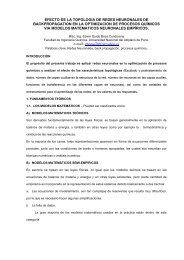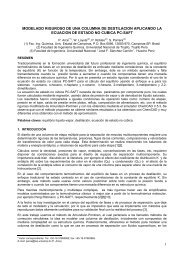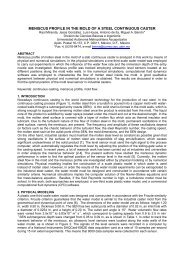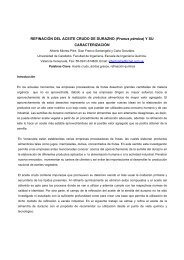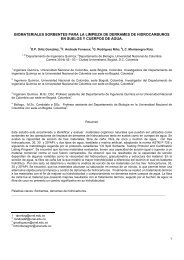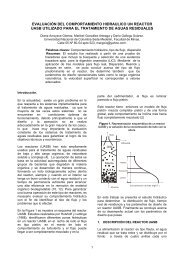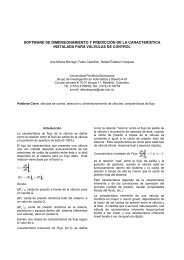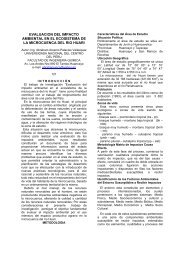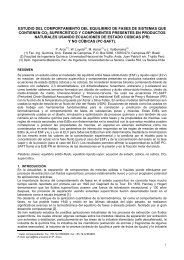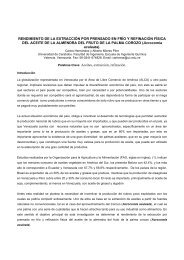degradation of agrochemicals in wastewaters by the photo-fenton ...
degradation of agrochemicals in wastewaters by the photo-fenton ...
degradation of agrochemicals in wastewaters by the photo-fenton ...
You also want an ePaper? Increase the reach of your titles
YUMPU automatically turns print PDFs into web optimized ePapers that Google loves.
DEGRADATION OF AGROCHEMICALS IN WASTEWATERS BY THE PHOTO-FENTON<br />
PROCESS: EXPERIMENTAL STUDY USING UV MERCURY VAPOR LAMPS AND<br />
SOLAR IRRADIATION<br />
Antonio C.S.C. Teixeira 1 , Giselle Stollar, Roberto Guardani, Cláudio A.O. Nascimento<br />
University <strong>of</strong> São Paulo – Chemical Eng<strong>in</strong>eer<strong>in</strong>g Department<br />
Av. Pr<strong>of</strong>. Luciano Gualberto, tr. 3, 380 - 05508-900 - São Paulo – SP – Brazil – Fax: +55-11-3813-2380<br />
1<br />
E-mail: acscteix@usp.br<br />
Key Words: <strong>photo</strong>-Fenton, <strong>agrochemicals</strong>, pesticides; wastewater<br />
Introduction<br />
Pesticides can be present <strong>in</strong> wastewater from<br />
<strong>in</strong>dustry and farm work operations (r<strong>in</strong>se water from<br />
spray equipment and empty pesticide conta<strong>in</strong>ers,<br />
post-harvest wash<strong>in</strong>g <strong>of</strong> fruits and vegetables,<br />
etc.). 1 The <strong>in</strong>adequate management <strong>of</strong> <strong>the</strong>se toxic<br />
recalcitrant residues can cause contam<strong>in</strong>ation <strong>of</strong><br />
<strong>the</strong> soil and <strong>of</strong> subterranean and surface water<br />
sources. Social and legal demands for<br />
environmental safety require <strong>the</strong>se impacts be<br />
m<strong>in</strong>imized.<br />
In general, wastewater remediation <strong>by</strong> conventional<br />
treatments (flocculation, adsorption, <strong>in</strong>c<strong>in</strong>eration,<br />
etc.), while <strong>of</strong>ten efficient, <strong>of</strong>ten merely transfers<br />
pollutants from one phase to ano<strong>the</strong>r. 2 Also, <strong>the</strong><br />
presence <strong>of</strong> non-biodegradable substances<br />
precludes <strong>the</strong> use <strong>of</strong> conventional activated-sludge<br />
systems. These demands have fueled <strong>the</strong><br />
development <strong>of</strong> more effective and economically<br />
viable methods for pollution control and prevention.<br />
Several <strong>photo</strong>chemical advanced oxidation<br />
processes (AOPs) are known that can ra<strong>the</strong>r<br />
unselectively oxidize a wide range <strong>of</strong> organic<br />
pollutants with a diversity <strong>of</strong> chemical structures<br />
and functional groups. 2-4 Under favorable<br />
conditions, <strong>the</strong> total decomposition <strong>of</strong> <strong>the</strong> organic<br />
constituents <strong>of</strong> <strong>the</strong> pollutant to carbon dioxide and<br />
water, plus <strong>in</strong>organic salts <strong>of</strong> all heteroatoms o<strong>the</strong>r<br />
than oxygen, is achieved. 5 In <strong>the</strong> AOPs carried out<br />
<strong>in</strong> homogeneous solution, <strong>the</strong> absorption <strong>of</strong> light<br />
triggers <strong>photo</strong>chemical and/or chemical reactions<br />
that produce hydroxyl radicals (HO • ), which react<br />
with <strong>the</strong> majority <strong>of</strong> organic substances with low<br />
selectivity and at rates <strong>of</strong>ten approach<strong>in</strong>g <strong>the</strong><br />
diffusion-controlled limit. 6<br />
Among AOPs, <strong>the</strong> <strong>photo</strong>-Fenton reaction is<br />
considered most promis<strong>in</strong>g for <strong>the</strong> remediation <strong>of</strong><br />
wastewater conta<strong>in</strong><strong>in</strong>g a variety <strong>of</strong> toxic nonbiodegradable<br />
organic compounds. 7 In <strong>the</strong> Fenton<br />
reaction, Fe(II) is oxidized to Fe(III), and H 2 O 2 is<br />
reduced to <strong>the</strong> hydroxide ion and <strong>the</strong> hydroxyl<br />
radical:<br />
Fe(II)+H 2 O 2<br />
⎯⎯→<br />
Fe(III)+HO • +OH − (1)<br />
In <strong>the</strong> absence <strong>of</strong> light, Fe(III) is reduced back to<br />
Fe(II) <strong>by</strong> hydrogen peroxide:<br />
Fe(III)+H 2 O 2 +H 2 O<br />
⎯⎯→<br />
Fe(II)+H 3 O + •−<br />
+HO 2<br />
(2)<br />
Reaction 2 is much slower than reaction 1, and<br />
ultimately determ<strong>in</strong>es <strong>the</strong> overall process rate. For<br />
<strong>the</strong> <strong>degradation</strong> <strong>of</strong> organic molecules, <strong>the</strong> optimum<br />
pH for <strong>the</strong> Fenton reaction is typically <strong>in</strong> <strong>the</strong> range<br />
3-4, and <strong>the</strong> optimum mass ratio Fe(II)/H 2 O 2 is 1.5. 8<br />
A more detailed description <strong>of</strong> <strong>the</strong>se reactions,<br />
consider<strong>in</strong>g hydrated iron-H 2 O 2 complexes,<br />
<strong>in</strong>clud<strong>in</strong>g rate constants and redox potentials is<br />
found <strong>in</strong> literature. 9<br />
Irradiation <strong>of</strong> Fenton systems with UV-visible<br />
irradiation strongly accelerates both Fenton and<br />
Fenton-like (H 2 O 2 /Fe(III)) reactions, improv<strong>in</strong>g<br />
<strong>degradation</strong> rates. 7 The optimum pH range is 2-4,<br />
<strong>in</strong> which <strong>the</strong> predom<strong>in</strong>ant Fe(III) species <strong>in</strong> aqueous<br />
solution is Fe(OH) 2+ , which absorbs out to 410 nm,<br />
undergo<strong>in</strong>g a relatively efficient <strong>in</strong>ternal light<strong>in</strong>duced<br />
redox reaction, yield<strong>in</strong>g hydroxyl radicals<br />
and regenerat<strong>in</strong>g Fe(II) (reaction 3): 10<br />
Fe(OH) 2+<br />
⎯⎯→<br />
hν<br />
Fe(II)+HO • (3)<br />
Also, <strong>photo</strong>chemical reactions <strong>of</strong> Fe(III)-L<br />
(L=organic <strong>in</strong>termediates, specially acids) are<br />
reported. These species exhibit strong ligand-tometal<br />
charge absorption bands <strong>in</strong> <strong>the</strong> near-UV and<br />
visible region <strong>of</strong> <strong>the</strong> spectrum (reaction 4):<br />
Fe(III)-L<br />
⎯⎯→<br />
h ν [Fe(III)-L] ∗ ⎯⎯→<br />
hν<br />
Fe(II)+L • (4)<br />
One <strong>of</strong> <strong>the</strong> common drawbacks <strong>of</strong> <strong>photo</strong>chemical<br />
processes is <strong>the</strong> great demand <strong>of</strong> electrical energy<br />
for UV lamps. 7 This can easily represent 60% <strong>of</strong> <strong>the</strong><br />
total operat<strong>in</strong>g expense <strong>of</strong> a lamp-based<br />
<strong>photo</strong>chemical reactor. A very <strong>in</strong>terest<strong>in</strong>g<br />
alternative is <strong>the</strong> use <strong>of</strong> solar light, which looks<br />
extremely attractive at sites with annual global<br />
<strong>in</strong>solation <strong>of</strong> 1700 kWh m -2 or higher. 2 The solar<br />
radiation <strong>in</strong>cident on <strong>the</strong> earth’s surface is split up<br />
<strong>in</strong>to <strong>the</strong> direct-beam radiation and <strong>the</strong> diffuse<br />
radiation. 11 Direct radiation is <strong>the</strong> solar radiation<br />
that reaches <strong>the</strong> surface without be<strong>in</strong>g scattered or
absorbed <strong>in</strong> <strong>the</strong> atmosphere. The diffuse<br />
component refers to scattered radiation.<br />
Comprehensive articles have been published for<br />
<strong>the</strong> last years concern<strong>in</strong>g ongo<strong>in</strong>g R&D directed<br />
towards solar <strong>photo</strong>catalytic reactors. 12<br />
Some papers have appeared <strong>in</strong> <strong>the</strong> literature<br />
describ<strong>in</strong>g <strong>the</strong> use <strong>of</strong> <strong>the</strong> <strong>photo</strong>-Fenton process for<br />
<strong>the</strong> <strong>degradation</strong> <strong>of</strong> waterborne pesticides. The<br />
<strong>degradation</strong> <strong>of</strong> triaz<strong>in</strong>e herbicides, 1 methylparathion,<br />
3 fenuron 13 , and diuron 1 are known<br />
examples. In this work, <strong>the</strong> variables <strong>in</strong>volved <strong>in</strong> <strong>the</strong><br />
<strong>photo</strong>-Fenton reaction, namely Fe(II) and H 2 O 2<br />
concentrations, radiation source, and pesticide<br />
chemical structure, were <strong>in</strong>vestigated <strong>in</strong> detail.<br />
circulated at 30 L m<strong>in</strong> -1 <strong>by</strong> means <strong>of</strong> a centrifugal<br />
pump. Each tube was positioned at <strong>the</strong> l<strong>in</strong>e-focus <strong>of</strong><br />
a parabolic trough collector <strong>of</strong> 0.26 m 2 reflect<strong>in</strong>g<br />
surface. The PTR was mounted on a fixed platform<br />
<strong>in</strong>cl<strong>in</strong>ed 23º (from ground) and fac<strong>in</strong>g North,<br />
accord<strong>in</strong>g to <strong>the</strong> latitude (23º32.0’S) and longitude<br />
(46º37.0’W) <strong>of</strong> São Paulo (Brazil).<br />
Methodology<br />
A schematic view <strong>of</strong> <strong>the</strong> bench-scale <strong>photo</strong>chemical<br />
reactor used <strong>in</strong> this work is shown <strong>in</strong> Fig. 1. The<br />
equipment consisted <strong>of</strong> an annular <strong>photo</strong>chemical<br />
reactor (Ace Glass, model 7863-20) with a net<br />
volume <strong>of</strong> 0.85 L, connected to a 1-L jacketed glass<br />
reservoir.<br />
Figure 1 - Schematic view <strong>of</strong> <strong>the</strong> bench-scale<br />
<strong>photo</strong>chemical reactor. M, rotat<strong>in</strong>g impeller connected to<br />
an agitator device. T, temperature sensor connected to a<br />
digital <strong>in</strong>dicator. pH, electrode connected to a digital pH<br />
meter.<br />
Two liters <strong>of</strong> <strong>the</strong> pesticide solution was circulated<br />
through <strong>the</strong> reactor and <strong>the</strong> tank at 0.025 L s -1 , and<br />
its temperature was controlled <strong>by</strong> means <strong>of</strong> a<br />
<strong>the</strong>rmo-regulated bath. The light source was a<br />
medium pressure mercury vapor lamp (Philips,<br />
model HPLN) placed <strong>in</strong>side a quartz-well (cutt<strong>in</strong>g<strong>of</strong>f<br />
radiation <strong>of</strong> wavelength shorter than 280 nm).<br />
Ferrioxalate act<strong>in</strong>ometry measurements 9 <strong>in</strong>dicated<br />
average polychromatic <strong>photo</strong>n fluxes <strong>of</strong> 2.2× 10 19<br />
and 4.6× 10 19 <strong>photo</strong>ns s -1 for 125 and 400-W<br />
lamps, respectively.<br />
A schematic view <strong>of</strong> <strong>the</strong> concentrat<strong>in</strong>g parabolictrough<br />
reactor (PTR) used <strong>in</strong> <strong>the</strong> solar experiments<br />
is shown <strong>in</strong> Fig. 2. The apparatus consisted <strong>of</strong> n<strong>in</strong>e<br />
flow-through borosilicate glass tubes <strong>in</strong> series,<br />
connected to a 10-L reservoir. 5 L <strong>of</strong> pesticide<br />
aqueous solution was treated <strong>in</strong> each batch,<br />
Figure 2 - Schematic view <strong>of</strong> <strong>the</strong> concentrat<strong>in</strong>g parabolictrough<br />
reactor (PTR), show<strong>in</strong>g one tube. M, rotat<strong>in</strong>g<br />
impeller connected to an agitator device. T, temperature<br />
sensor connected to a digital <strong>in</strong>dicator. pH, electrode<br />
connected to a digital pH meter.<br />
The experimental procedure was <strong>the</strong> same <strong>in</strong> all<br />
runs. The pesticide aqueous solution, prepared<br />
from commercial agrochemical formulations or from<br />
<strong>the</strong> active compounds, was firstly <strong>in</strong>troduced <strong>in</strong>to<br />
<strong>the</strong> reactor. pH was adjusted at 3.0 <strong>by</strong> <strong>the</strong> addition<br />
<strong>of</strong> H 2 SO 4 , and <strong>the</strong>n cont<strong>in</strong>uously monitored.<br />
Weighed amount <strong>of</strong> solid FeSO 4 .7H 2 O (>98%,<br />
Sigma Aldrich) was added, and <strong>the</strong> system was<br />
exposed to light. The H 2 O 2 solution, prepared us<strong>in</strong>g<br />
an analytical grade stock-solution (30% w/w <strong>in</strong><br />
water, Merck), was <strong>in</strong>troduced at a controlled flow<br />
rate (13.3 µ L s -1 ), <strong>by</strong> means <strong>of</strong> a peristaltic pump<br />
(Ismatec-IPC). In <strong>the</strong> follow<strong>in</strong>g sections, [H 2 O 2 ]<br />
refer to <strong>the</strong> hydrogen peroxide concentration <strong>of</strong> <strong>the</strong><br />
feed solution, and [Fe(II)] to <strong>the</strong> iron concentration<br />
<strong>of</strong> <strong>the</strong> aqueous solution <strong>in</strong> <strong>the</strong> reactor.<br />
Ten-milliliter samples were taken from <strong>the</strong> reservoir<br />
at specified times for <strong>the</strong> characterization <strong>of</strong><br />
pollutant <strong>degradation</strong>. The chemical oxygen<br />
demand (COD) <strong>of</strong> each sample was measured <strong>by</strong><br />
<strong>the</strong> closed-reflux colorimetric method. 14 The<br />
concentration <strong>of</strong> dissolved organic carbon (DOC)<br />
was measured us<strong>in</strong>g <strong>the</strong> Shimadzu 5000A<br />
equipment. A quench<strong>in</strong>g solution conta<strong>in</strong><strong>in</strong>g KI,<br />
Na 2 SO 3 and NAOH (0.1 mol L -1 each) was added to<br />
<strong>the</strong> samples <strong>in</strong> <strong>the</strong> proportion 5:2 v/v<br />
(sample:solution) <strong>in</strong> order to decompose residual<br />
H 2 O 2 and precipitate iron species. All samples were<br />
filtered through a 0.22- µ m membrane before DOC<br />
analysis. The biochemical oxygen demand (BOD 5 )<br />
<strong>of</strong> <strong>the</strong> f<strong>in</strong>al treated solution was measured <strong>by</strong> <strong>the</strong><br />
respirometric method 14 us<strong>in</strong>g <strong>the</strong> Oxitop IS 12<br />
manometric respirometer (WTW).
The Laboratory <strong>of</strong> Micrometeorology (Astronomical<br />
and Geophysical Institute, University <strong>of</strong> São Paulo)<br />
provided solar radiation data. Global radiation was<br />
measured every five m<strong>in</strong>utes with a pyranometer<br />
(Eppley, model PBW) <strong>in</strong> <strong>the</strong> range 285 to 2800 nm.<br />
The diffuse component was measured <strong>by</strong> means <strong>of</strong><br />
a pyranometer (Eppley, model PSP) with a shad<strong>in</strong>g<br />
r<strong>in</strong>g to elim<strong>in</strong>ate direct radiation. Fig. 3 shows a<br />
typical solar irradiance pr<strong>of</strong>ile, and <strong>the</strong><br />
correspond<strong>in</strong>g accumulated radiant energy.<br />
Ferrioxalate act<strong>in</strong>ometry <strong>in</strong>dicated an average<br />
polychromatic <strong>photo</strong>n flux equal to 1.9× 10 21<br />
<strong>photo</strong>ns s -1 . All solar experiments were carried out<br />
with<strong>in</strong> a few weeks, so that seasonal effects were<br />
not important.<br />
irradiance (W m -2 )<br />
1000<br />
800<br />
600<br />
400<br />
200<br />
0<br />
12 13 14 15 16 17 18<br />
local time (h)<br />
10000<br />
8000<br />
6000<br />
4000<br />
2000<br />
0<br />
accumulated radiant<br />
energy (kJ m -2 )<br />
Figure 3 - Direct and diffuse (broken l<strong>in</strong>es) radiation<br />
measurements (left ord<strong>in</strong>ate axis) and correspond<strong>in</strong>g<br />
accumulated radiant energy (right ord<strong>in</strong>ate axis).<br />
Results and Discussion<br />
The <strong>photo</strong>-Fenton <strong>degradation</strong> <strong>of</strong> three<br />
<strong>agrochemicals</strong> was estudied: tebuconazole<br />
(fungicide), methamidophos (<strong>in</strong>secticide/acaricide),<br />
and clomazone (herbicide).<br />
1. experiments with tebuconazole<br />
Aqueous solutions (1 g L -1 ) <strong>of</strong> tebuconazole ((RS)-<br />
1-p-chlorophenyl-4,4-dimethyl-3-(1H-1,2,4-triazol-1-<br />
ylmethyl)pentan-3-ol, Fig. 4), prepared with <strong>the</strong><br />
formulation Folicur ® PE (wettable powder, 25% w/v<br />
<strong>in</strong> active compound, Bayer CropScience), were<br />
used. These solutions had COD 0 =224±27 mg L -1 ;<br />
DOC 0 =70±5 mg L -1 ; BOD 5 =187 mg L -1 . The results<br />
<strong>of</strong> <strong>the</strong> experiments are shown <strong>in</strong> Figs. 5 to 8.<br />
Cl−<br />
−<br />
−<br />
OH<br />
2− − −<br />
CH CH C C CH<br />
2 3<br />
N<br />
CH 2<br />
CH 3<br />
N<br />
CH 3<br />
Figure 4 - Molecular structure <strong>of</strong> tebuconazole.<br />
N<br />
The <strong>photo</strong>-Fenton reaction (Fig. 5, experiment P8-<br />
L) showed a rapid removal <strong>of</strong> DOC (89%) and COD<br />
(86%). The <strong>in</strong>crease <strong>in</strong> <strong>in</strong>organic carbon<br />
concentration (3 to 18 mg L -1 ) and <strong>the</strong> variation <strong>of</strong><br />
pH (3 to 2.62, associated with <strong>the</strong> formation <strong>of</strong><br />
organic acids) suggested <strong>the</strong> m<strong>in</strong>eralization <strong>of</strong><br />
tebuconazole and <strong>in</strong>ert compounds. The dark<br />
Fenton process (experiment P13-L), on <strong>the</strong> o<strong>the</strong>r<br />
hand, showed a DOC removal <strong>of</strong> only 11%. In this<br />
case, <strong>the</strong> generation <strong>of</strong> HO • radicals slowed down<br />
after reaction 1, and <strong>the</strong> addition <strong>of</strong> relatively large<br />
amounts <strong>of</strong> iron would be required <strong>in</strong> order to<br />
degrade <strong>the</strong> pollutant. 7,8<br />
DOC (mg L -1 )<br />
100<br />
80<br />
60<br />
40<br />
20<br />
0<br />
0 50 100 150 200<br />
irradiation time (m<strong>in</strong>utes)<br />
P8-L<br />
P13-L<br />
Figure 5 - Results <strong>of</strong> <strong>the</strong> experiments carried out with<br />
tebuconazole at 30 o C, 400-W lamp. P8-L (<strong>photo</strong>-Fenton;<br />
[H 2 O 2 ]=0.5 mol L -1 ; [Fe(II)]=0.0005 mol L -1 ); P13-L<br />
(Fenton; [H 2 O 2 ]=0.5 mol L -1 ; [Fe(II)]=0.0005 mol L -1 ).<br />
DOC (mg L -1 )<br />
COD (mg L -1 )<br />
100<br />
80<br />
60<br />
40<br />
20<br />
0<br />
250<br />
200<br />
150<br />
100<br />
50<br />
0<br />
0 50 100 150 200<br />
irradiation time (m<strong>in</strong>utes)<br />
0 50 100 150 200<br />
irradiation time (m<strong>in</strong>utes)<br />
P9-L<br />
P12-L<br />
P9-L<br />
P12-L<br />
Figure 6 - Results <strong>of</strong> <strong>the</strong> <strong>photo</strong>-Fenton experiments<br />
carried out with tebuconazole, 400-W lamp. P9-L (30 o C;<br />
[H 2 O 2 ]=0.05 mol L -1 ; [Fe(II)]=0.0005 mol L -1 ); P12-L<br />
(50 o C; [H 2 O 2 ]=0.05 mol L -1 ; [Fe(II)]=0.0005 mol L -1 ).
Therefore, irradiation <strong>of</strong> <strong>the</strong> Fenton system not only<br />
regenerated Fe(II), <strong>the</strong> crucial catalytic species <strong>in</strong><br />
<strong>the</strong> Fenton reaction (reactions 3 and 4), but also<br />
produced an additional HO • radical, <strong>the</strong> species<br />
responsible for oxidative cha<strong>in</strong> reactions. Moreover,<br />
s<strong>in</strong>ce Fe(II) was regenerated <strong>by</strong> light, <strong>the</strong> <strong>photo</strong>-<br />
Fenton process consumed less H 2 O 2 and required<br />
only catalytic amounts <strong>of</strong> Fe(II).<br />
Fig. 6 shows that DOC-time curves were virtually<br />
<strong>the</strong> same at 30 and 50 o C (experiments P9-L and<br />
P12-L). In experiment P12-L, <strong>the</strong> concentration <strong>of</strong><br />
organic compounds that could be oxidized at any<br />
time should be smaller, while <strong>the</strong> carbon balance <strong>in</strong><br />
both experiments was ra<strong>the</strong>r similar. In spite <strong>of</strong> <strong>the</strong><br />
fact that reactions 3 and 4 are less sensitive to<br />
temperature, 6,7,10 this could suggest different<br />
reaction pathways at each temperature.<br />
Fig. 7 <strong>in</strong>dicates that <strong>in</strong>creas<strong>in</strong>g [H 2 O 2 ] <strong>in</strong> <strong>the</strong> range<br />
0.01-0.1 mol L -1 had not a significant effect. For<br />
[H 2 O 2 ]=0.5 mol L -1 (experiment P8-L), DOC and<br />
COD removals <strong>of</strong> 68 and 73%, respectively, were<br />
obta<strong>in</strong>ed <strong>in</strong> <strong>the</strong> first 60 m<strong>in</strong>utes. DOC and COD<br />
percent removals after 180 m<strong>in</strong>utes were about<br />
90%, associated with a rapid variation <strong>in</strong> pH values<br />
from 3.00 to 2.62, measured after 30 m<strong>in</strong>utes.<br />
Fig 7. also shows that a five-fold <strong>in</strong>crease <strong>in</strong> [Fe(II)]<br />
did not seem to have a significant effect on DOC<br />
and COD-time-evolution. This behavior could be<br />
attributed to <strong>the</strong> <strong>photo</strong>catalytic effect. 7<br />
BOD 5 was determ<strong>in</strong>ed for samples taken at t=0 and<br />
t=180 m<strong>in</strong>utes for a <strong>photo</strong>-Fenton experiment<br />
carried at 30 o C, [H 2 O 2 ]=0.055 mol L -1 , and<br />
[Fe(II)]=0.00055 mol L -1 . Fig. 8 shows a f<strong>in</strong>al COD<br />
removal <strong>of</strong> 66%, along with an almost five-fold<br />
<strong>in</strong>crease <strong>in</strong> BOD 5 . The BOD 5 /COD ratio varied from<br />
2.7 to 36%. The <strong>in</strong>creased biodegradability was <strong>of</strong><br />
great importance, <strong>in</strong> view <strong>of</strong> <strong>the</strong> use <strong>of</strong> <strong>the</strong> <strong>photo</strong>-<br />
Fenton reaction as a prelim<strong>in</strong>ary step prior to a<br />
conventional activated-sludge biological treatment.<br />
COD or BOD5 (mg L -1 )<br />
250<br />
200<br />
150<br />
100<br />
50<br />
0<br />
186.5<br />
63.5<br />
t=0<br />
t=180 m<strong>in</strong>utes<br />
COD BOD 5<br />
5<br />
23<br />
DOC (mg L -1 )<br />
COD (mg L -1 )<br />
100<br />
80<br />
60<br />
40<br />
20<br />
0<br />
250<br />
200<br />
150<br />
100<br />
50<br />
0<br />
0 50 100 150 200<br />
irradiation time (m<strong>in</strong>utes)<br />
0 50 100 150 200<br />
irradiation time (m<strong>in</strong>utes)<br />
P6-L<br />
P8-L<br />
P9-L<br />
PE1<br />
PE3<br />
P6-L<br />
P8-L<br />
P9-L<br />
PE1<br />
PE3<br />
Figure 8 – Results <strong>of</strong> <strong>the</strong> <strong>photo</strong>-Fenton experiment<br />
carried out with tebuconazole at 30 o C, [H 2 O 2 ]=0.055 mol<br />
L -1 ; [Fe(II)]=0.00055 mol L -1 , 400-W lamp.<br />
2. experiments with methamidophos<br />
The experiments with methamidophos ((RS)-O,Sdimethyl<br />
phosphoramidothioate, Fig. 9), were<br />
carried out with an aqueous solution (1 mL L -1 ) <strong>of</strong><br />
<strong>the</strong> formulation Tamaron ® BR (concentrated liquid<br />
emulsion, 60% w/v <strong>in</strong> active compound, Bayer<br />
CropScience), which had COD 0 =864±12 mg L -1 ;<br />
DOC 0 =245±8 mg L -1 ; and BOD 5 =5 mg L -1 . The<br />
results are presented <strong>in</strong> Fig. 10.<br />
O<br />
NH 2<br />
P<br />
O−CH 3<br />
S−CH 3<br />
Figure 9 - Molecular structure <strong>of</strong> methamidophos.<br />
Figure 7 - Results <strong>of</strong> <strong>the</strong> <strong>photo</strong>-Fenton experiments<br />
carried out with tebuconazole at 30 o C, 400-W lamp. P6-L<br />
([H 2 O 2 ]=0.05 mol L -1 ; Fe(II)]=0.0028 mol L -1 ); P8-L<br />
([H 2 O 2 ]=0.5 mol L -1 ; Fe(II)]=0.0005 mol L -1 ); P9-L<br />
([H 2 O 2 ]=0.05 mol L -1 ; Fe(II)]=0.0005 mol L -1 ); PE1<br />
([H 2 O 2 ]=0.1 mol L -1 ; Fe(II)]=0.00055 mol L -1 ); PE3<br />
([H 2 O 2 ]=0.01 mol L -1 ; Fe(II)]=0.00055 mol L -1 ).<br />
Fig. 10 shows a slow decrease <strong>of</strong> DOC values with<br />
time for experiments TM1 and TM2 (f<strong>in</strong>al removals<br />
<strong>of</strong> 6 and 18%, respectively). A huge <strong>in</strong>crease <strong>in</strong><br />
[H 2 O 2 ] toge<strong>the</strong>r with an <strong>in</strong>crease <strong>in</strong> [Fe(II)] were<br />
needed to obta<strong>in</strong> <strong>the</strong> behavior shown after 60<br />
m<strong>in</strong>utes <strong>in</strong> experiment TM3, with 82% carbon<br />
removal after 180 m<strong>in</strong>utes. These results also<br />
suggest <strong>the</strong> generation <strong>of</strong> stable <strong>degradation</strong><br />
products without a substantial variation <strong>in</strong> DOC
concentration, which could be ma<strong>in</strong>ly acids, s<strong>in</strong>ce<br />
pH varied <strong>in</strong> <strong>the</strong> ranges 3.03-2.47 (TM1), and 3.04-<br />
2.01 (TM2). In experiment TM3, pH rema<strong>in</strong>ed<br />
virtually constant, due to <strong>the</strong> excess <strong>of</strong> H 2 O 2 , and<br />
faster pollutant m<strong>in</strong>eralization.<br />
400<br />
DOC (mg L -1 )<br />
300<br />
200<br />
100<br />
0<br />
0 50 100 150 200<br />
irradiation time (m<strong>in</strong>utes)<br />
TM1<br />
TM2<br />
TM3<br />
Figure 10 - Results <strong>of</strong> <strong>the</strong> <strong>photo</strong>-Fenton experiments<br />
carried out with methamidophos at 30 o C, 400-W lamp.<br />
TM1 ([H 2 O 2 ]=0.055 mol L -1 ; [Fe(II)]=0.00055 mol L -1 );<br />
TM2 ([H 2 O 2 ]=0.55 mol L -1 ; [Fe(II)]=0.00055 mol L -1 ); TM3<br />
([H 2 O 2 ]=8 mol L -1 ; [Fe(II)]=0.001 mol L -1 ).<br />
The comparison <strong>of</strong> COD results <strong>in</strong> Figs. 7 and 10<br />
suggest that <strong>the</strong> pr<strong>in</strong>cipal mechanisms <strong>of</strong> reaction<br />
<strong>of</strong> hydroxyl radicals with organic compounds 9<br />
seemed to be less operative <strong>in</strong> <strong>the</strong> case <strong>of</strong><br />
methamidophos, ow<strong>in</strong>g to its recalcitrance. In fact,<br />
a small <strong>in</strong>crease <strong>in</strong> [H 2 O 2 ] had a more pronounced<br />
effect on tebuconazole <strong>degradation</strong>.<br />
3. experiments with clomazone<br />
In <strong>the</strong> case <strong>of</strong> clomazone (2-(2-chlorobenzyl)-4,4-<br />
dimethyl-1,2-oxazolid<strong>in</strong>-3-one, Fig. 11), aqueous<br />
solutions (0.185 g L -1 ) <strong>of</strong> <strong>the</strong> active compound (91%<br />
w/v, Clariant) were used. These solutions had<br />
COD 0 =271±35 mg L -1 and DOC 0 =97±10 mg L -1 . A<br />
standard 24-h toxicity test with Artemia sp nauplii 15<br />
resulted <strong>in</strong> CL 50 =84 mg L -1 .<br />
O<br />
CH 3<br />
−<br />
CH 3<br />
O<br />
Cl<br />
N−CH 2−<br />
Figure 11 - Molecular structure <strong>of</strong> clomazone.<br />
Experiments were carried out accord<strong>in</strong>g to a<br />
Doehlert uniform experimental design, 16 <strong>in</strong> which<br />
<strong>the</strong> effects <strong>of</strong> <strong>the</strong> molar ratio H 2 O 2 :C and [Fe(II)]<br />
were studied at a constant <strong>photo</strong>n flux (2.2 × 10 19<br />
<strong>photo</strong>ns s -1 , 125-W lamp). The experimental po<strong>in</strong>ts<br />
can be represented as <strong>the</strong> apexes and <strong>the</strong> center <strong>of</strong><br />
a hexagon (Fig. 12).<br />
Figure 12 - Graphical representation <strong>of</strong> <strong>the</strong> Doehlert<br />
uniform array. Variables X 1 and X 2 are normalized. The<br />
experiment numbers are <strong>in</strong>dicated near <strong>the</strong> apexes and<br />
<strong>the</strong> center <strong>of</strong> <strong>the</strong> hexagon.<br />
Figs. 13 to 15 compare <strong>the</strong> results <strong>of</strong> <strong>the</strong><br />
experiments <strong>in</strong> which [Fe(II)] was held constant at<br />
different levels. At [Fe(II)]=0.0001 mol L -1<br />
(experiments CLZ-L4 and CLZ-L5, Fig. 13), <strong>the</strong><br />
irradiation time, <strong>in</strong> m<strong>in</strong>utes, required to achieve a<br />
DOC removal <strong>of</strong> 50% relative to <strong>the</strong> <strong>in</strong>itial DOC (t 50 )<br />
varied from 38 to 21 m<strong>in</strong>utes when H 2 O 2 :C varied<br />
from 1.625 to 3.875, respectively. DOC removals<br />
after 180 m<strong>in</strong>utes were about 88%. COD-time<br />
curves behaved similarly. In experiment CLZ-L5,<br />
pH decreased from 3.05 to 2.44.<br />
DOC (mg L -1 )<br />
COD (mg L -1 )<br />
120<br />
100<br />
80<br />
60<br />
40<br />
20<br />
0<br />
400<br />
300<br />
200<br />
100<br />
0<br />
0 50 100 150 200<br />
irradiation time (m<strong>in</strong>utes)<br />
0 50 100 150 200<br />
irradiation time (m<strong>in</strong>utes)<br />
CLZ-L4<br />
CLZ-L5<br />
CLZ-L4<br />
CLZ-L5<br />
Figure 13 - Results <strong>of</strong> <strong>the</strong> <strong>photo</strong>-Fenton experiments<br />
carried out with clomazone at 30 o C and [Fe(II)]=0.0001<br />
mol L -1 , 125-W lamp. CLZ-L4 (H 2 O 2 :C=1.625); CLZ-L5<br />
(H 2 O 2 :C=3.875).<br />
Fig. 14 ([Fe(II)]=0.00055 mol L -1 ) shows that a 5.5-<br />
fold <strong>in</strong>crease <strong>in</strong> peroxide concentration enabled fast<br />
pesticide <strong>degradation</strong>. t 50 varied from 87 to 19 and<br />
8 m<strong>in</strong>utes when H 2 O 2 :C varied from 0.5 to 2.75 and<br />
5 (experiments CLZ-L3, CLZ-L1, and CLZ-L6,
espectively); <strong>the</strong> correspond<strong>in</strong>g DOC removals<br />
after 180 m<strong>in</strong>utes were 66, 88, and 88%,<br />
respectively.<br />
DOC (mg L -1 )<br />
COD (mg L -1 )<br />
120<br />
100<br />
80<br />
60<br />
40<br />
20<br />
0<br />
400<br />
300<br />
200<br />
100<br />
0<br />
0 50 100 150 200<br />
irradiation time (m<strong>in</strong>utes)<br />
0 50 100 150 200<br />
irradiation time (m<strong>in</strong>utes)<br />
CLZ-L1<br />
CLZ-L3<br />
CLZ-L6<br />
CLZ-L1<br />
CLZ-L3<br />
CLZ-L6<br />
Figure 14 - Results <strong>of</strong> <strong>the</strong> <strong>photo</strong>-Fenton experiments<br />
carried out with clomazone at 30 o C and [Fe(II)]=0.00055<br />
mol L -1 , 125-W lamp. CLZ-L1 (H 2 O 2 :C=2.75); CLZ-L3<br />
(H 2 O 2 :C=0.5); CLZ-L6 (H 2 O 2 :C=5).<br />
At <strong>the</strong> maximum Fe(II) concentration, Fig. 15 shows<br />
no remarkable modification <strong>of</strong> DOC and COD-time<br />
curves was observed when H 2 O 2 :C varied from<br />
1.625 to 3.875 (experiments CLZ-L2 and CLZ-L7,<br />
respectively). Total m<strong>in</strong>eralization <strong>of</strong> <strong>the</strong> pesticide<br />
was achieved <strong>in</strong> <strong>the</strong> first 30 m<strong>in</strong>utes <strong>in</strong> both cases.<br />
The <strong>photo</strong>-Fenton <strong>degradation</strong> <strong>of</strong> clomazone should<br />
be less susceptible to peroxide concentration at<br />
high [Fe(II)] tak<strong>in</strong>g <strong>in</strong>to account <strong>the</strong> importance <strong>of</strong><br />
<strong>the</strong> <strong>the</strong>rmal Fenton reactions.<br />
Figs. 16 and 17 compare <strong>the</strong> results <strong>of</strong> <strong>the</strong><br />
experiments <strong>in</strong> which H 2 O 2 :C was held constant at<br />
H 2 O 2 :C=1.625. The <strong>in</strong>crease <strong>in</strong> <strong>the</strong> Fe(II)<br />
concentration from 0.0001 to 0.001 mol L -1 led to a<br />
decrease <strong>in</strong> t 50 from 38 to 6 m<strong>in</strong>utes, and to an<br />
<strong>in</strong>crease <strong>in</strong> DOC removal after 180 m<strong>in</strong>utes <strong>of</strong><br />
irradiation from 88 to 100% (experiments CLZ-L4<br />
and CLZ-L2, respectively).<br />
DOC (mg L -1 )<br />
120<br />
100<br />
80<br />
60<br />
40<br />
20<br />
0<br />
0 50 100 150 200<br />
irradiation time (m<strong>in</strong>utes)<br />
CLZ-L2<br />
CLZ-L4<br />
DOC (mg L -1 )<br />
120<br />
100<br />
80<br />
60<br />
40<br />
20<br />
CLZ-L2<br />
CLZ-L7<br />
COD (mg L -1 )<br />
400<br />
300<br />
200<br />
100<br />
CLZ-L2<br />
CLZ-L4<br />
0<br />
0 50 100 150 200<br />
irradiation time (m<strong>in</strong>utes)<br />
0<br />
0 50 100 150 200<br />
irradiation time (m<strong>in</strong>utes)<br />
COD (mg L -1 )<br />
400<br />
300<br />
200<br />
100<br />
0<br />
0 50 100 150 200<br />
irradiation time (m<strong>in</strong>utes)<br />
CLZ-L2<br />
CLZ-L7<br />
Figure 15 - Results <strong>of</strong> <strong>the</strong> <strong>photo</strong>-Fenton experiments<br />
carried out with clomazone at 30 o C and [Fe(II)]=0.001<br />
mol L -1 , 125-W lamp. CLZ-L2 (H 2 O 2 :C=1.625); CLZ-L7<br />
(H 2 O 2 :C=3.875).<br />
Figure 16 - Results <strong>of</strong> <strong>the</strong> <strong>photo</strong>-Fenton experiments<br />
carried out with clomazone at 30 o C and H 2 O 2 :C=1.625,<br />
125-W lamp. CLZ-L2 ([Fe(II)]=0.001 mol L -1 ); CLZ-L4<br />
([Fe(II)]=0.0001 mol L -1 ).<br />
A similar but less remarkable behavior was<br />
obta<strong>in</strong>ed at H 2 O 2 :C=3.875 (Fig. 17). t 50 varied from<br />
21 to 8 m<strong>in</strong>utes, and DOC removal after 180<br />
m<strong>in</strong>utes <strong>of</strong> irradiation <strong>in</strong>creased from 89 to 100%<br />
(experiments CLZ-L5 and CLZ-L7, respectively).<br />
These results suggested that <strong>the</strong> <strong>photo</strong>-Fenton<br />
<strong>degradation</strong> <strong>of</strong> clomazone <strong>in</strong> aqueous solution was<br />
less dependent <strong>of</strong> Fe(II) concentration when<br />
H 2 O 2 :C was at <strong>the</strong> maximum level. Moreover, <strong>the</strong><br />
effect <strong>of</strong> [Fe(II)] on <strong>the</strong> <strong>in</strong>itial pollutant <strong>degradation</strong>
ate seemed to be more important than on <strong>the</strong> long<br />
term COD removal.<br />
DOC (mg L -1 )<br />
COD (mg L -1 )<br />
120<br />
100<br />
80<br />
60<br />
40<br />
20<br />
0<br />
400<br />
300<br />
200<br />
100<br />
0<br />
0 50 100 150 200<br />
irradiation time (m<strong>in</strong>utes)<br />
0 50 100 150 200<br />
irradiation time (m<strong>in</strong>utes)<br />
CLZ-L5<br />
CLZ-L7<br />
CLZ-L5<br />
CLZ-L7<br />
Figure 17 - Results <strong>of</strong> <strong>the</strong> <strong>photo</strong>-Fenton experiments<br />
carried out with clomazone at 30 o C and H 2 O 2 :C=3.875,<br />
125-W lamp. CLZ-L5 ([Fe(II)]=0.0001 mol L -1 ); CLZ-L7<br />
([Fe(II)]=0.001 mol L -1 ).<br />
The central po<strong>in</strong>t <strong>of</strong> <strong>the</strong> Doehlert design (Fig. 12)<br />
was repeated at different conditions. Fig. 18 shows<br />
that clomazone was very stable under UV radiation,<br />
with a DOC removal less than 20% after 180<br />
m<strong>in</strong>utes <strong>of</strong> irradiation. When H 2 O 2 was added, DOC<br />
values rema<strong>in</strong>ed relatively constant up to ca. 60<br />
m<strong>in</strong>utes, followed <strong>by</strong> <strong>the</strong> oxidation <strong>of</strong> <strong>the</strong> pesticide<br />
with a DOC removal <strong>of</strong> 87%.<br />
DOC (mg L -1 )<br />
120<br />
100<br />
80<br />
60<br />
40<br />
20<br />
0<br />
0 50 100 150 200<br />
irradiation time (m<strong>in</strong>utes)<br />
CLZ-L1<br />
CLZ-L1R2<br />
CLZ-L1R3<br />
CLZ-L1R4<br />
Figure 18 - Results <strong>of</strong> <strong>the</strong> experiments carried out at <strong>the</strong><br />
central po<strong>in</strong>t <strong>of</strong> <strong>the</strong> Doehlert array at 30 o C. CLZ-L1<br />
(<strong>photo</strong>-Fenton; H 2 O 2 :C=2.75; [Fe(II)]=0.00055 mol L -1 ;<br />
125-W lamp); CLZ-L1R2 (UV; 125-W lamp); CLZ-L1R3<br />
(H 2 O 2 /UV; H 2 O 2 :C=2.75; 125-W lamp); CLZ-L1R4<br />
(Fenton; H 2 O 2 :C=2.75; [Fe(II)]=0.00055 mol L -1 ).<br />
The dark Fenton reaction enabled a faster <strong>in</strong>itial<br />
<strong>degradation</strong> <strong>in</strong> comparison with <strong>the</strong> H 2 O 2 /UV<br />
process, but its long-term performance resulted <strong>in</strong><br />
only 40% DOC removal. This was due to <strong>the</strong><br />
cessation <strong>of</strong> HO • radicals production after <strong>the</strong><br />
complete conversion <strong>of</strong> Fe(II) to Fe(III) <strong>by</strong> reaction<br />
1. The <strong>photo</strong>chemically enhanced Fenton reaction,<br />
on <strong>the</strong> o<strong>the</strong>r hand, enabled to obta<strong>in</strong> residual DOC<br />
values (88% removal) after ca. 60 m<strong>in</strong>utes.<br />
The results <strong>of</strong> <strong>the</strong> Doehlert experimental design<br />
were analyzed us<strong>in</strong>g <strong>the</strong> s<strong>of</strong>tware Statgraphics Plus<br />
3.0. For <strong>the</strong> DOC percent removal (Y 1 ), <strong>the</strong><br />
follow<strong>in</strong>g quadratic response surface model was<br />
obta<strong>in</strong>ed:<br />
2 2<br />
Y1 88 + 6.9X1<br />
+ 5.8X<br />
2 + 11X<br />
1 + 12X<br />
2 − 0.5X1X<br />
2<br />
= (5)<br />
For this model, R 2 =0.89, <strong>the</strong> average <strong>of</strong> <strong>the</strong><br />
residues (difference between experimental and<br />
calculated values <strong>of</strong> <strong>the</strong> response Y 1 ) is 2.17, and<br />
<strong>the</strong> average standard deviation <strong>of</strong> <strong>the</strong> residues is<br />
1.54. No auto-correlation between <strong>the</strong> residues and<br />
<strong>the</strong> experimental and calculated values <strong>of</strong> <strong>the</strong><br />
response, and <strong>the</strong> <strong>in</strong>dependent variables X 1<br />
(H 2 O 2 :C) and X 2 ([Fe(II)]) was observed. Fig. 19<br />
shows <strong>the</strong> response surface.<br />
Y 1<br />
(DOC % removal)<br />
109<br />
99<br />
89<br />
79<br />
69<br />
0.9 0.6<br />
0.3 0 -0.3<br />
-0.6<br />
X ([Fe(II)])<br />
2<br />
-0.9<br />
-1<br />
1<br />
0.6<br />
0.2<br />
-0.2<br />
-0.6<br />
X 1<br />
(H 2<br />
O 2<br />
:C)<br />
Figure 19 – Response surface for DOC removal <strong>in</strong> terms<br />
<strong>of</strong> normalized variables X 1 (H 2 O 2 :C) and X 2 ([Fe(II)]).<br />
As discussed, <strong>the</strong> molar ratio H 2 O 2 :C has a<br />
remarkable effect on <strong>the</strong> DOC percent removal<br />
after 180 m<strong>in</strong>utes <strong>of</strong> irradiation. At <strong>the</strong> two levels <strong>of</strong><br />
[Fe(II)] considered, DOC removal <strong>in</strong>creases with<br />
<strong>the</strong> <strong>in</strong>crease <strong>in</strong> peroxide concentration, with a<br />
maximum at about H 2 O 2 :C=3.65. The subsequent<br />
decrease <strong>in</strong> DOC removal is probably due to <strong>the</strong><br />
excess <strong>of</strong> peroxide. In this case HO • radicals can<br />
be trapped <strong>by</strong> H 2 O 2 , lead<strong>in</strong>g to <strong>the</strong> formation <strong>of</strong><br />
hydroperoxyl radicals (HO 2 • ) that are much less<br />
reactive than hydroxyl radicals. 2 Also, Fig. 19<br />
shows that <strong>the</strong> DOC percent removal decreases<br />
with <strong>the</strong> decrease <strong>in</strong> [Fe(II)], particularly at<br />
H 2 O 2 :C=0.5 (X 1 =-1). The model confirms <strong>the</strong><br />
important conjo<strong>in</strong>t effect exerted <strong>by</strong> Fe(II) and H 2 O 2<br />
on pesticide <strong>degradation</strong>.
In <strong>the</strong> case <strong>of</strong> t 50 (Y 2 ), <strong>the</strong> quadratic surface<br />
response model is given <strong>by</strong>:<br />
2 2<br />
Y 2 18.8−<br />
25.7X1<br />
− 8.6X<br />
2 + 28.6X1<br />
−10.4X<br />
2 + 11.4X1X<br />
2<br />
= (6)<br />
For this model, R 2 =0.80, <strong>the</strong> average <strong>of</strong> <strong>the</strong><br />
residues is 7.66, and <strong>the</strong> standard deviation <strong>of</strong> <strong>the</strong><br />
residues is 5.08. No auto-correlation between <strong>the</strong><br />
residues, <strong>the</strong> responses, and <strong>the</strong> <strong>in</strong>dependent<br />
variables was observed. The response surface (Fig.<br />
20) shows that t 50 notably decreases with <strong>the</strong><br />
<strong>in</strong>crease <strong>in</strong> <strong>the</strong> molar ratio H 2 O 2 :C, at both iron<br />
concentrations studied. For H 2 O 2 :C held at 0.5<br />
(X 1 =-1), t 50 seems to decrease with <strong>the</strong> <strong>in</strong>crease <strong>in</strong><br />
Fe(II) concentration. The response surface<br />
suggests a region <strong>of</strong> m<strong>in</strong>imum t 50 about<br />
H 2 O 2 :C=3.65 and [Fe(II)]=0.0005 mol L -1 .<br />
under solar irradiation. For example, t 50 =23 and 6<br />
m<strong>in</strong> (CLZ-S2 and CLZ-L2, respectively), and 12 and<br />
8 m<strong>in</strong> (CLZ-S6 and CLZ-L6, respectively). DOC<br />
percent removals after 180 m<strong>in</strong>utes <strong>of</strong> irradiation<br />
were correspond<strong>in</strong>gly similar.<br />
DOC (mg L -1 )<br />
120<br />
100<br />
80<br />
60<br />
40<br />
20<br />
0<br />
0 50 100 150 200<br />
irradiation time (m<strong>in</strong>utes)<br />
CLZ-S3<br />
CLZ-S6<br />
Y2 ( t50, m<strong>in</strong>utes)<br />
100<br />
80<br />
60<br />
40<br />
20<br />
0.30.60.9<br />
0<br />
-1 .30<br />
-0.6 -0.2 0.2 -0.6-0<br />
0.6 X<br />
2<br />
([Fe(II )])<br />
1 -0 .9<br />
X 1 (H 2 O 2 :C)<br />
Figure 20 – Surface response for t 50 (equation 6) <strong>in</strong> terms<br />
<strong>of</strong> normalized variables X 1 (H 2 O 2 :C) and X 2 ([Fe(II)]).<br />
Some experiments <strong>of</strong> <strong>the</strong> Doehlert design (Fig. 12)<br />
were carried out <strong>in</strong> <strong>the</strong> parabolic trough solar<br />
reactor (PTR) at <strong>the</strong> same H 2 O 2 :C and [Fe(II)].<br />
Solar irradiation conditions were <strong>in</strong> average similar<br />
to those illustrated <strong>in</strong> Fig. 3, correspond<strong>in</strong>g to clear,<br />
sunny days with <strong>the</strong> sky free or almost free from<br />
mov<strong>in</strong>g clouds. Therefore, <strong>the</strong> accumulated direct<br />
energy <strong>in</strong>put was comparable <strong>in</strong> most experiments<br />
dur<strong>in</strong>g most <strong>of</strong> <strong>the</strong> time.<br />
Fig. 21 compares DOC-time curves for experiments<br />
carried out at constant Fe(II) concentration and<br />
variable H 2 O 2 :C molar ratio. At [Fe(II)]=0.00055 mol<br />
L -1 , t 50 varied from 67 to 12 m<strong>in</strong>utes when H 2 O 2 :C<br />
varied from 0.5 to 5 (experiments CLZ-S3 and CLZ-<br />
S6, respectively); <strong>the</strong> correspond<strong>in</strong>g DOC removals<br />
were similar after 180 m<strong>in</strong>utes <strong>of</strong> solar irradiation,<br />
about 86%. At <strong>the</strong> maximum Fe(II) concentration,<br />
t 50 varied from 23 to 16 m<strong>in</strong>utes when H 2 O 2 :C<br />
varied from 1.625 to 3.875 (experiments CLZ-S2<br />
and CLZ-S7, respectively). Total m<strong>in</strong>eralization <strong>of</strong><br />
clomazone was achieved <strong>in</strong> <strong>the</strong> first 90 m<strong>in</strong>utes <strong>in</strong><br />
experiment CLZ-S2; <strong>in</strong> experiment CLZ-S7, DOC<br />
removal after 180 m<strong>in</strong>utes reached 92%. These<br />
results obta<strong>in</strong>ed <strong>in</strong> <strong>the</strong> parabolic trough solar<br />
reactor, parallel those depicted <strong>in</strong> Figs. 14 and 15<br />
correspond<strong>in</strong>g to lamp-irradiated systems. As<br />
expected, <strong>the</strong> values <strong>of</strong> t 50 were generally higher<br />
DOC (mg L -1 )<br />
120<br />
100<br />
80<br />
60<br />
40<br />
20<br />
0<br />
0 50 100 150 200<br />
irradiation time (m<strong>in</strong>utes)<br />
CLZ-S2<br />
CLZ-S7<br />
Figure 21 - Results <strong>of</strong> <strong>the</strong> <strong>photo</strong>-Fenton experiments<br />
carried out with clomazone <strong>in</strong> <strong>the</strong> solar PTR. CLZ-S2<br />
(H 2 O 2 :C=1.625; [Fe(II)]=0.001 mol L -1 ); CLZ-S3<br />
(H 2 O 2 :C=0.5; [Fe(II)]=0.00055 mol L -1 ); CLZ-S6<br />
(H 2 O 2 :C=5; [Fe(II)]=0.00055 mol L -1 ); CLZ-S7<br />
(H 2 O 2 :C=3.875; [Fe(II)]=0.001 mol L -1 ).<br />
Fig. 22 compares <strong>the</strong> results <strong>of</strong> a solar experiment<br />
<strong>in</strong> which H 2 O 2 :C was held at 1.625 and [Fe(II)] was<br />
varied. The value <strong>of</strong> t 50 was somewhat higher <strong>in</strong><br />
experiment CLZ-S4 (31 m<strong>in</strong>utes), as expected.<br />
DOC-time curves and DOC percent removals after<br />
180m m<strong>in</strong>utes were comparable, <strong>in</strong> contrast to <strong>the</strong><br />
results obta<strong>in</strong>ed <strong>in</strong> <strong>the</strong> bench lamp reactor (Fig. 16).<br />
This behavior could be associate with <strong>the</strong><br />
significant temperature <strong>in</strong>crease observed under<br />
<strong>in</strong>solation <strong>in</strong> experiment CLZ-S4 (from 28 to 46 o C),<br />
that could have quickened <strong>the</strong>rmal oxidation<br />
reactions. pH values also underwent a higher<br />
decrease <strong>in</strong> experiment CLZ-S2 (from 3.04 to 2.19)<br />
<strong>in</strong> comparison with CLZ-S4 (3 to 2.42).<br />
The comparison <strong>of</strong> experiment CLZ-S5 with<br />
experiments CLZ-S4 (at constant [Fe(II)]), and with<br />
CLZ-S7 (at constant H 2 O 2 :C) deserves careful<br />
analysis. At H 2 O 2 :C=3.875 (Fig. 23), <strong>the</strong> <strong>in</strong>crease <strong>of</strong><br />
Fe(II) concentration from 0.0001 to 0.001 mol L -1<br />
led to a decrease <strong>in</strong> t 50 from 54 to 16 m<strong>in</strong>utes<br />
(experiments CLZ-S5 and CLZ-S7, respectively),<br />
while DOC percent removal varied from 79 to 92%.
These results are <strong>in</strong> agreement with those shown <strong>in</strong><br />
Fig. 17, even though <strong>the</strong> values <strong>of</strong> t 50 and DOC<br />
percent removal for experiment CLZ-S5 were<br />
notably different from those obta<strong>in</strong>ed <strong>in</strong> CLZ-L5 (21<br />
m<strong>in</strong>utes and 89%, respectively). Even consider<strong>in</strong>g<br />
<strong>the</strong> differences <strong>in</strong> <strong>in</strong>itial DOC, Fig. 23 shows that<br />
<strong>the</strong> performance <strong>of</strong> experiment CLZ-S5 was<br />
unexpectedly poor <strong>in</strong> comparison with CLZ-S4,<br />
carried out at a lower H 2 O 2 :C ratio. This was due to<br />
<strong>the</strong> abrupt modification <strong>of</strong> sky conditions dur<strong>in</strong>g <strong>the</strong><br />
experiment CLZ-S5 (Fig. 24).<br />
enhances <strong>the</strong> Fenton reaction, and comparable<br />
DOC removals are obta<strong>in</strong>ed. In <strong>the</strong> case <strong>of</strong> vary<strong>in</strong>g<br />
irradiance caused <strong>by</strong> <strong>the</strong> passage <strong>of</strong> clouds (Fig.<br />
24), <strong>the</strong> values <strong>of</strong> H 2 O 2 :C and [Fe(II)] may be<br />
manipulated <strong>in</strong> such a way that <strong>the</strong> <strong>the</strong>rmal Fenton<br />
reaction could compensate for <strong>the</strong> decrease <strong>in</strong> <strong>the</strong><br />
<strong>photo</strong>n <strong>in</strong>put rate. This can also be possible after<br />
<strong>the</strong> middle afternoon when <strong>the</strong> irradiation naturally<br />
falls <strong>of</strong>f. However, it should be emphasized that<br />
Fe(II) levels <strong>in</strong> disposed water are subject to<br />
environmental regulations, and toge<strong>the</strong>r with H 2 O 2 ,<br />
to economical restrictions.<br />
DOC (mg L -1 )<br />
120<br />
100<br />
80<br />
60<br />
40<br />
20<br />
0<br />
0 50 100 150 200<br />
irradiation time (m<strong>in</strong>utes)<br />
CLZ-S2<br />
CLZ-S4<br />
irradiance (W m -2 )<br />
1000<br />
800<br />
600<br />
400<br />
200<br />
0<br />
11.5 12.5 13.5 14.5<br />
local time (h)<br />
7000<br />
6000<br />
5000<br />
4000<br />
3000<br />
2000<br />
1000<br />
0<br />
accumulated radiant<br />
energy (kJ m -2 )<br />
Figure 22 - Results <strong>of</strong> <strong>the</strong> <strong>photo</strong>-Fenton experiments<br />
carried out with clomazone <strong>in</strong> <strong>the</strong> solar PTR at<br />
H 2 O 2 :C=1.625. CLZ-S2 ([Fe(II)]=0.001 mol L -1 ); CLZ-S4<br />
([Fe(II)]=0.0001 mol L -1 ).<br />
DOC (mg L -1 )<br />
140<br />
120<br />
100<br />
80<br />
60<br />
40<br />
20<br />
0<br />
0 50 100 150 200<br />
irradiation time (m<strong>in</strong>utes)<br />
CLZ-S4<br />
CLZ-S5<br />
CLZ-S7<br />
Figure 23 - Results <strong>of</strong> <strong>the</strong> <strong>photo</strong>-Fenton experiments<br />
carried out with clomazone <strong>in</strong> <strong>the</strong> solar PTR. CLZ-S4<br />
(H 2 O 2 :C=1.625; [Fe(II)]=0.0001 mol L -1 ); CLZ-S5<br />
(H 2 O 2 :C=3.875; [Fe(II)]=0.0001 mol L -1 ); CLZ-S7<br />
(H 2 O 2 :C=3.875; [Fe(II)]=0.001 mol L -1 ).<br />
In solar <strong>photo</strong>chemical reactors <strong>the</strong> <strong>in</strong>cident<br />
radiation is not a manipulated variable, but may be<br />
treated as a measured disturbance <strong>in</strong> <strong>the</strong> process.<br />
Also, concentrat<strong>in</strong>g solar systems are not suited to<br />
capture diffuse sunlight under cloudy conditions as<br />
efficiently as <strong>the</strong>y do for direct solar beams. The<br />
conditions mapped <strong>by</strong> <strong>the</strong> Doehlert matrix design<br />
may <strong>the</strong>refore provide a valuable guide to def<strong>in</strong>e<br />
operational strategies when atmospheric and<br />
wea<strong>the</strong>r conditions change <strong>in</strong> <strong>the</strong> course <strong>of</strong> <strong>the</strong><br />
treatment process. For example, under <strong>in</strong>solation<br />
conditions like those shown <strong>in</strong> Fig. 3, lower levels <strong>of</strong><br />
H 2 O 2 and Fe(II) may be used, s<strong>in</strong>ce solar light<br />
Figure 24 - Direct and diffuse (broken l<strong>in</strong>es) radiation<br />
measurements (left ord<strong>in</strong>ate axis) and correspond<strong>in</strong>g<br />
accumulated radiant energy (right ord<strong>in</strong>ate axis).<br />
Experiment CLZ-S5.<br />
Conclusions<br />
The experimental results presented <strong>in</strong> this work<br />
confirm <strong>the</strong> <strong>photo</strong>-Fenton reaction as a very<br />
effective process to oxidize <strong>agrochemicals</strong> <strong>of</strong><br />
different chemical structures (fungicides,<br />
<strong>in</strong>secticides, herbicides etc.) <strong>in</strong> aqueous solutions.<br />
The process showed to be superior to o<strong>the</strong>r AOPs,<br />
at any Fe(II) and H 2 O 2 concentrations, due to<br />
stronger light penetration and absorption up to 410<br />
nm under homogeneous <strong>photo</strong>catalysis. In some<br />
cases, more than 90% <strong>of</strong> <strong>the</strong> DOC and COD could<br />
be removed after 180 m<strong>in</strong>utes <strong>of</strong> irradiation, us<strong>in</strong>g<br />
125 and 400-W mercury vapor lamps or under solar<br />
irradiation on clear sunny days. Pollutant removal<br />
was noticeably accelerated when [H 2 O 2 ] or H 2 O 2 :C<br />
was <strong>in</strong>creased at constant [Fe(II)]. This behavior<br />
makes <strong>the</strong> commercial use <strong>of</strong> solar-driven <strong>photo</strong>-<br />
Fenton processes environmentally attractive,<br />
lower<strong>in</strong>g electrical energy costs. In this case,<br />
parabolic-trough solar reactors seem to an<br />
<strong>in</strong>terest<strong>in</strong>g technology. The <strong>in</strong>crease <strong>in</strong> <strong>the</strong><br />
BOD 5 /COD ratio, <strong>in</strong> addition to <strong>the</strong> fast COD<br />
removal after short irradiation times suggest <strong>the</strong><br />
use <strong>of</strong> <strong>the</strong> <strong>photo</strong>-Fenton reaction as a prelim<strong>in</strong>ary<br />
step prior to conventional biological treatment<br />
processes.
Acknowledgements<br />
The authors would like to thank FAPESP and CNPq<br />
for f<strong>in</strong>ancial support. S<strong>in</strong>cere thanks are also<br />
directed to Bayer CropScience, Clariant and to<br />
Pr<strong>of</strong>. Dr. Gilberto Batista (LARP/ESALQ-USP), for<br />
pesticide samples, and to <strong>the</strong> Laboratory <strong>of</strong><br />
Micrometeorology (Astronomical and Geophysical<br />
Institute, University <strong>of</strong> São Paulo) for solar radiation<br />
data.<br />
Bibliography<br />
(1) Burrows, H. D.; Canle, L. M.; Santaballa, J. A.;<br />
Steenken, S. (2002), Reaction pathways and<br />
mechanisms <strong>of</strong> <strong>photo</strong><strong>degradation</strong> <strong>of</strong> pesticides. J.<br />
Photochem. Photobiol. B - Biol., 67, 71.<br />
(2) Teixeira, A. C. S. C.; Guardani, R.; Nascimento, C. A.<br />
O. (2003), Solar <strong>photo</strong>chemical <strong>degradation</strong> <strong>of</strong><br />
am<strong>in</strong>osilicones conta<strong>in</strong>ed <strong>in</strong> liquid effluents. Process<br />
studies and neural network model<strong>in</strong>g. Ind. Eng. Chem.<br />
Res., 42, 5751.<br />
(3) Chiron, S.; Fernandez-Alba, A.; Rodriguez, A.;<br />
Garcia-Calvo, E. (1999), Pesticide chemical oxidation:<br />
state-<strong>of</strong>-<strong>the</strong>-art. Water Res., 34, 366.<br />
(4) Will, I. B. S.; Moraes, J. E. F.; Teixeira, A. C .S. C.;<br />
Guardani, R.; Nascimento, C. A. O. (2004),<br />
Photo<strong>degradation</strong> <strong>of</strong> wastewater conta<strong>in</strong><strong>in</strong>g organic<br />
compounds <strong>in</strong> solar reactors. Sep. Purif. Technol., 34,<br />
51.<br />
(11) Duffie, J. A.; Beckman, W. A. (1991), Solar<br />
Eng<strong>in</strong>eer<strong>in</strong>g <strong>of</strong> Thermal Processes, 2 nd . Ed., Wiley, New<br />
York.<br />
(12) Alfano, O. M.; Bahnemann, D.; Cassano, A. E.;<br />
Dillert, R.; Goslich, R. (2000), Photocatalysis <strong>in</strong> water<br />
environments us<strong>in</strong>g artificial and solar light. Catal. Today,<br />
58, 199.<br />
(13) Acero, J. L.; Benitez, F. J.; Gonzalez, M.; Benitez, R.<br />
(2002), K<strong>in</strong>etics <strong>of</strong> fenuron decomposition <strong>by</strong> s<strong>in</strong>glechemical<br />
oxidants and comb<strong>in</strong>ed systems. Ind. Eng.<br />
Chem. Res., 41, 4225.<br />
(14) Standard Methods for <strong>the</strong> Exam<strong>in</strong>ation <strong>of</strong> Water and<br />
Wastewater (1998), Clesceri, L. S.; Greenberg, A. E.;<br />
Eaton, A. D.; Franson, M. A. H. (Eds.). American Public<br />
Health Association, American Water Works Association<br />
and Water Environment Federation, Wash<strong>in</strong>gton, DC.<br />
(15) Vanhaecke, P.; Persoone, G.; Claus, C. (1980),<br />
Research on <strong>the</strong> development <strong>of</strong> a short-term standard<br />
toxicity test with Artemia nauplii. In: Persoone, G.;<br />
Sorgeloos, P.; Roels, O.; Jaspers, E. (Eds.). The Br<strong>in</strong>e<br />
Shrimp Artemia. Morphology, Genetics, Radiobiology,<br />
Toxicology. Universo Press, Wetteren, Belgium, 263.<br />
(16) Duménil, G.; Mattei, G.; Sergent, M.; Bertrand, J. C.;<br />
Laget, M.; Phan-Tan-Luu, R. (1988), Application <strong>of</strong> a<br />
Doehlert experimental design to <strong>the</strong> optimization <strong>of</strong><br />
microbial <strong>degradation</strong> <strong>of</strong> crude oil <strong>in</strong> sea water <strong>by</strong><br />
cont<strong>in</strong>uous culture. Appl. Microbiol. Biotechnol. 27, 405.<br />
(5) Teixeira, A. C. S. C.; Guardani, R. and Nascimento,<br />
C. A. O. (2004), Photo-Fenton remediation <strong>of</strong><br />
<strong>wastewaters</strong> conta<strong>in</strong><strong>in</strong>g silicones: experimental study and<br />
neural network model<strong>in</strong>g. Chem. Eng. Technol., 27, 800.<br />
(6) Nascimento, C. A. O.; Teixeira, A. C. S .C.; Guardani,<br />
R.; Qu<strong>in</strong>a, F. H.; Lopez-Gejo, J. (2004), Degradación<br />
Fotoquímica de Compuestos Orgánicos de Origen<br />
Industrial. In: Nudelman, N. (Ed.). Química Sustentable.<br />
Ediciones UNL - Universidad Nacional del Litoral, Santa<br />
Fé, Argent<strong>in</strong>a, 206-220.<br />
(7) Oliveros, E.; Legr<strong>in</strong>i, O.; Hohl, M.; Müller, T.; Braun,<br />
A.M. (1997), Industrial wastewater treatment: large-scale<br />
development <strong>of</strong> a light-enhanced Fenton reaction. Chem.<br />
Eng. Proc., 36, 397.<br />
(8) Bigda, R. (1995), Consider Fenton’s chemistry for<br />
wastewater treatment. Chem. Eng. Prog., (Dec.), 62.<br />
(9) Bossmann, S. H.; Oliveros, E.; Göb, S.; Siegwart, S.;<br />
Dahlen, E. P.; Payawan, L.; Straub, M.; Wörner, M.;<br />
Braun, A. M. (1998), New evidence aga<strong>in</strong>st hydroxyl<br />
radicals as reactive <strong>in</strong>termediates <strong>in</strong> <strong>the</strong> <strong>the</strong>rmal and<br />
<strong>photo</strong>chemically enhanced Fenton Reactions. J. Phys.<br />
Chem. A, 102, 5542.<br />
(10) Pozdnyakov. I. P.; Glebov, E. M.; Plyusn<strong>in</strong>, V. F.;<br />
Griv<strong>in</strong>, V. P.; Ivanov, Y. V.; Voro<strong>by</strong>ev, D. Y.; Bazh<strong>in</strong>, N.<br />
M. (2000), Mechanism <strong>of</strong> Fe(OH) 2+ (aq) <strong>photo</strong>lysis <strong>in</strong><br />
aqueous solution. Pure Appl. Chem., 72, 2187.



